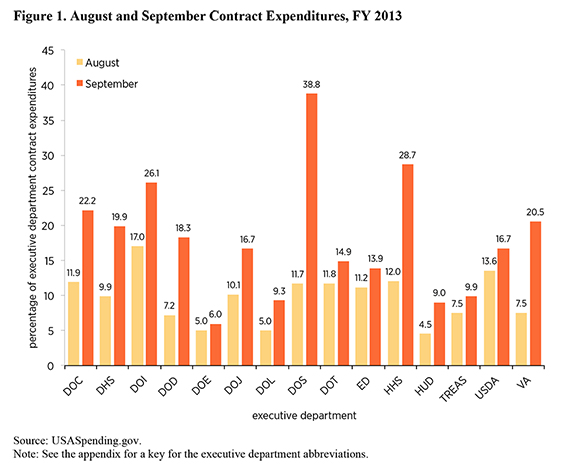- | Academic & Student Programs Academic & Student Programs
- | Government Spending Government Spending
- | Working Papers Working Papers
- |
Curbing the Surge in Year-End Federal Government Spending: Reforming ‘Use It or Lose It’ Rules
In this paper, we examine existing literature on the prevalence, consequences, wastefulness, and causes of year-end spending surges. We then report executive departments’ year-end obligated federal contract expenditure patterns using data obtained from USASpending.gov. We review literature on purported solutions to curb year-end spending surges, and conclude with a policy recommendation of our own.
The “use it or lose it” phenomenon refers to the propensity of US government agencies to spend unused financial resources toward the end of the fiscal year out of fear that leftover resources will be returned to the Department of the Treasury and will prompt future congressional budget cuts for the agency. While anecdotes and media stories of year-end spending surges are widespread, empirical evidence for year-end spending surges and use-it-or-lose-it spending or the motivation behind it is significantly less available. As we discuss in the next section, while the budget and spending literature has examined the efficacy of various policy solutions designed to curb year-end spending surges, these studies often lack empirical evidence. In this paper, we examine existing literature on the prevalence, consequences, wastefulness, and causes of year-end spending surges. We then report executive departments’ year-end obligated federal contract expenditure patterns, using data obtained from USASpending.gov. We review literature on purported solutions to curb year-end spending and conclude with a policy recommendation.
Literature Survey on Year-End Spending Surges and Whether Use It or Lose It Is to Blame
Research suggests that year-end spending surges may facilitate wasteful spending. In a 2007 survey of Department of Defense financial management and contracting careerists, 95 percent of the respondents believe there is a problem with year-end agency spending. In their 2013 paper, economists Jeffrey Liebman and Neale Mahoney analyze data from the Federal Procurement Data System and the White House’s IT Dashboard to show not only that is there a surge in federal spending at the end of the year, but also that this spending is of lower quality. According to Liebman and Mahoney, at the end of a fiscal year, “the prospect of expiring funds” causes agencies to spend all their remaining resources, “even if the marginal value is below the social costs of funds (our definition of wasteful spending).”
In 1998, the US General Accounting Office (GAO) reported that the number of year-end spending surges had declined since 1980, when Congress and the GAO first looked at the issue. Among more than 3,200 Inspectors General reports, the GAO found only one that linked poor contracting practices with a high rate of year-end spending. However, the GAO cautions that its analysis is limited because of “agencies’ widespread reporting noncompliance” and “the absence of complete and accurate reporting” of agencies’ spending. A 2007 study partially confirmed the existence of year-end spending surges on the federal level by analyzing the spending patterns of military hospitals that are completely reliant on congressional appropriations for funding.
However, some observers point out that little empirical evidence exists to prove that there is a link between year-end spending surges and the US federal budget process. A panel of budget experts at the International Public Management Network Symposium largely concluded that while year-end spending surges exist, little empirical evidence supports the use-it-or-lose-it phenomenon. Panel member Fred Thompson of Willamette University calls the use-it-or-lose-it phenomenon’s key premise—that fears of future budget cuts drive exhaustive spending—an “urban legend.” He points to the timing of the budget process, explaining that budget proposals are “formulated during the prior fiscal year and enacted into law well before the books [close] on the current year.” He also argues that because year-end spending surges exist at agencies in state governments and in Canada, US federal budgeting patterns cannot be a unique source. Panel member Robert D. Behn of Harvard University argues that year-end spending surges may in fact be “socially optimal” and doubts the assumption that they are inherently wasteful.
To speak with a scholar or learn more on this topic, visit our contact page.


